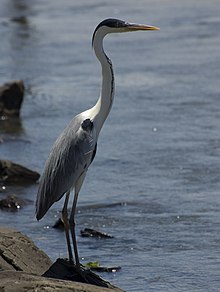Coconut heron
| Coconut heron | ||||||||||||
|---|---|---|---|---|---|---|---|---|---|---|---|---|

Cocoa heron ( Ardea cocoi ) |
||||||||||||
| Systematics | ||||||||||||
|
||||||||||||
| Scientific name | ||||||||||||
| Ardea cocoi | ||||||||||||
| Linnaeus , 1766 |
The Cocoi Heron ( Ardea cocoi ) is a South American heron. It is the largest heron in its range. Subspecies are not described for this heron species. It is a widespread and common species. However, relatively little is known about its way of life.
Appearance
Cocoa herons reach a height of 97 to 127 centimeters and weigh an average of around 1900 grams. The plumage is predominantly gray, white and black. There is no gender dimorphism .
The head cap is black and extends over the eyes. In some individuals, this head cap is slightly lightened in the forehead area. There are elongated feathers at the back of the head. The beak is dark yellow, the base of the beak is blackish. In the breeding dress the beak turns a bright yellow. The base of the beak is then slightly reddish. The iris is yellow. The neck is white, the back and wings are gray. If you are in a very upright position, you will also see a black shoulder mark. The under tail and the flanks are white. The belly is black. The legs are pink.
Distribution area and habitat
The coconut heron is common throughout South America. It is only missing in the Andes and on the southern tip of the South American continent. It is rare on the west coast from Chile to Ecuador. It is mainly considered a resident bird. The southern populations migrate further north in the southern hemisphere during winter. However, the exact train movements have not yet been adequately investigated.
Its habitat are wetlands. It occurs in both salt and fresh water marshes. It looks for its food in shallow to deep water along the banks of lakes, rivers, estuaries, grass marshes and swamps. It occurs mainly in the lowlands, but has also been observed at altitudes up to 2500 meters above sea level.
Food and foraging
The coconut heron searches for food in a manner typical of many of the great egret species by slowly scanning the water and standing up waiting for prey to get close. He goes in search of food both during the day and at night and basically alone. He defends his food territory against conspecifics. The food mainly consists of large fish, but it also eats frogs and the larvae of aquatic insects and also goes to carrion. Occasionally it steals prey from other species such as the forest stork .
Reproduction
The beginning of the breeding season depends on the respective distribution area. The breeding season begins in Suriname in July, in Uruguay, however, in October and in Buenos Aires in November. It nests in swamps and other places inaccessible to predators. Trees with a height of 20 to 25 meters are preferred as nesting sites. But there are also nests in the reed belt and on cacti.
It often nests individually. But there are also large breeding colonies known in which it breeds together with other species as well as other species. In Suriname there is a breeding colony with 400 to 800 pairs of Cocoir Herons in the coastal region. The nest is made of twigs, dry thistles and reeds and padded with grass. Nests have a diameter of about 65 centimeters and a deep nest hollow. The clutch size in Argentina is on average 3 eggs. The eggs are sky blue and have whitish spots. The incubation period is 20 to 23 days.
supporting documents
Single receipts
literature
- James A. Kushlan, James A. Hancock, illustrated by David Thelwell: The Herons . In: Bird families of the world . tape 14 . Oxford University Press , Oxford 2005, ISBN 0-19-854981-4 .
Web links
- Ardea cocoi inthe IUCN 2013 Red List of Threatened Species . Listed by: BirdLife International, 2012. Retrieved November 21, 2013.
